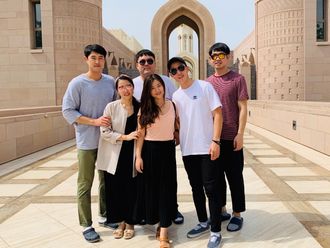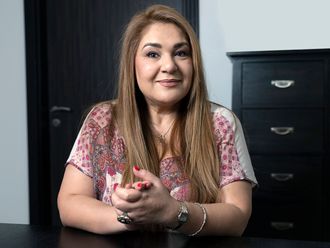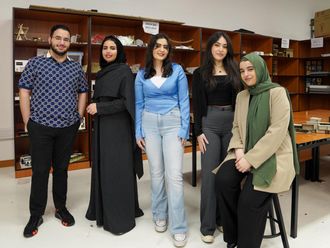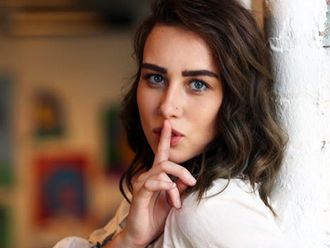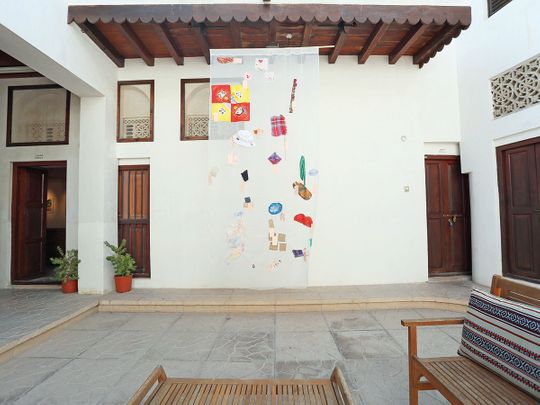
Hung from a bare mud wall in the historic Al Fahidi District in Dubai, a sheet of sheer fabric has been attracting a steady stream of visitors. Throughout the day, curious eyes gaze intriguingly at this white sheet stitched with patches of embroidery, prayer ribbons, travel memorabilia and crochet hearts. Titled Fragmented Memories, the textile installation, is on display at Tashkeel, Al Fahidi. Curated through weekly community stitching sessions, held by artist and designer Natalya Konforti, it is a part of her immersive exhibition, Rainbows Under Their Feet.
Over 30 women participated in these community stitching sessions and left behind slices of their cherished memories sewed across the fabric. ‘I called them slow stitching sessions and they earned their name well. The meetups were incredibly peaceful and meditative,’ shares Natalya, who initiated the project, as part of her two-month long, solo residency at Tashkeel, Al Fahidi.
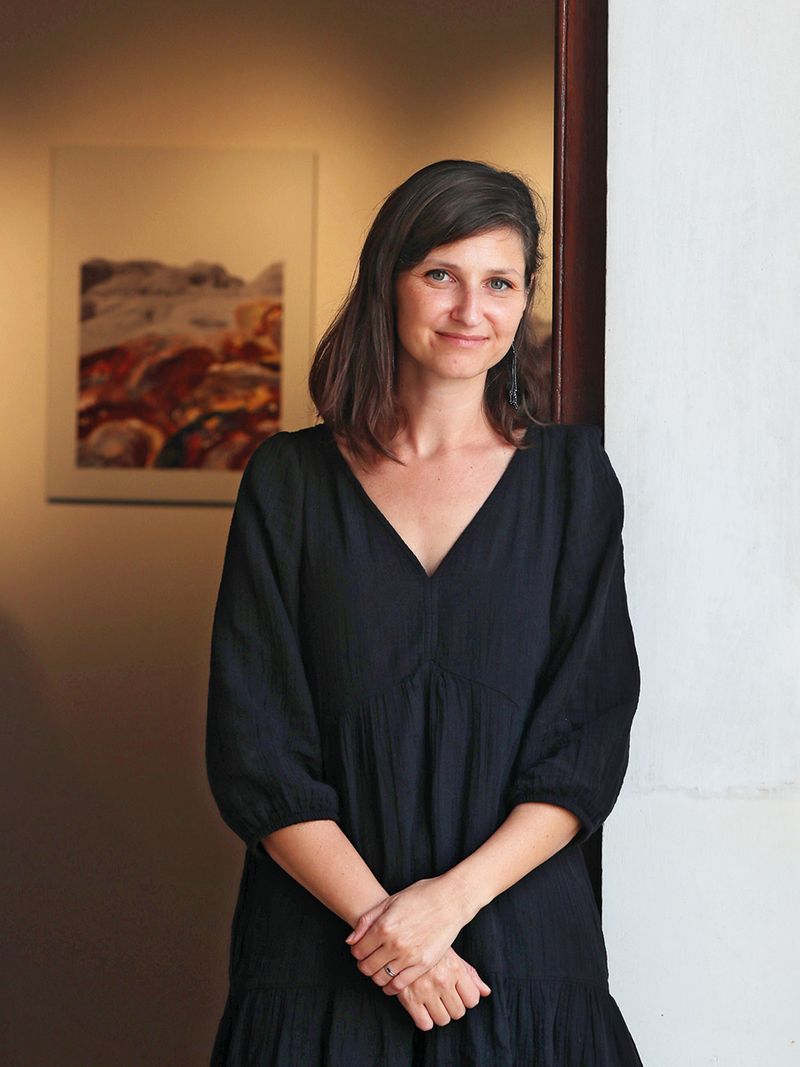
Exploring genealogical and geological memories, Natalya attempted to use stitching and quilting as tools of storytelling and keepsakes, passed down from generations. Her stitching workshops saw women from all walks of life join, including several pairs of mothers and daughters. The women brought along pieces of their wedding dresses, holiday souvenirs, embroidery squares and other cherished fabrics. ‘When I explained the concept of bringing a fabric which evokes a memory, most people responded immediately, telling me that they knew exactly what to bring,’ she tells.
As a curator, she also chose to relinquish control of the outcome, letting her participants chart their sewing pattern. ‘Rather than giving any directions, I let my guests decide what to include and where to stitch. It was a refreshing experience watching it come alive,’ she adds.
Gathering on a long communal table in the open courtyard, the women stitched, and shared stories, turning the workshop into an interactive social experience. Each piece of fabric for them, evoked personal memories.
Dubai-based Indian expat and freelance copywriter, Nidhi Kumar, had brought two cloth pieces – a travel memento from a fun trip to Japan and a ragged piece of a picnic mat that she had purchased from a supermarket years ago. ‘The red scarf with traditional Japanese face masks was a reminder of a memorable holiday. It had been torn and mended. The picnic mat was from my early days in Dubai, used during numerous beach picnics and park trips, a witness to several unforgettable adventures and cherished conversations I’ve had with friends and acquaintances,’ says Nidhi, explaining why she chose these two particular pieces. Crochet and embroidery, she shares, were her pandemic hobbies that she hopes to actively continue. Attending the community sessions gave her a peek into new stitching patterns and helped her keep abreast of what fellow crocheters were creating.
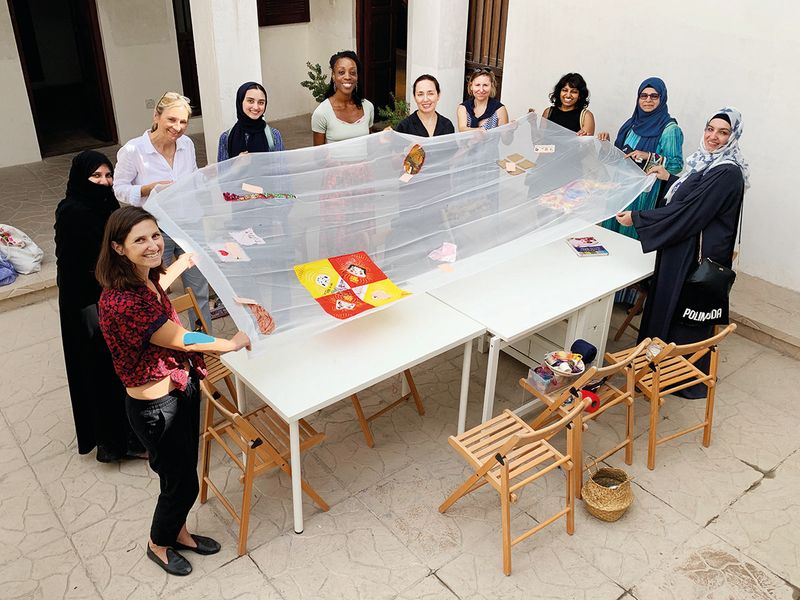
Iraqi expat, artist and photographer, Jehan Ali, grew up in homes, where aunts and grandmas would sew myriads of garments for every occasion. So, in a way embroidery and stitching had always been a part of her life. The call for community stitching resonated deeply with Jehan, who found the entire experience extremely therapeutic. ‘It was such a calming process and the group was very supportive. I stitched a shred of a beautiful satin fabric cut out from a wedding gift, I had received from my sister-in-law, almost 19 years ago,’ she shares, along with seaming a green prayer ribbon, in keeping with a native Iraqi custom of tying such ribbons around shrines, when a wish is fulfilled. In a few of the workshops, she was also accompanied by her 12-year-old daughter, who added crocheted hearts on the sheet.
For Natalya, listening to these shared stories behind the fabrics, was one of the most cherished moments during her residency. ‘Sitting in a circle with hands busy stitching, conversations naturally begin to flow. Quilting, in particular, has been an inter-generational activity, where knowledge is passed along. In fact, we had four mother-and-daughter-pairs join us throughout the month and many others spoke of their grandmothers’, and even great grandmothers’ textiles they had inherited,’ she tells.
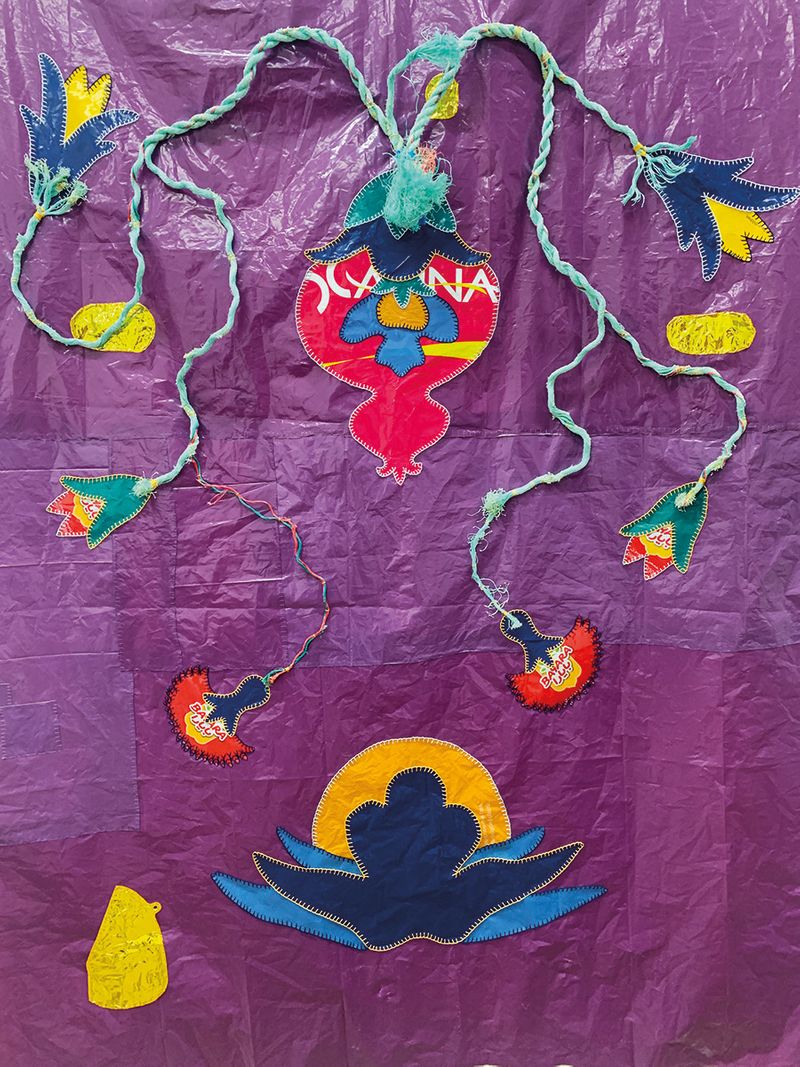
Viewing the final outcome of the community sessions, beautifully amalgamated on the sheer sheet triggered an emotional response in Indian expat, Saba Azim, who is also a deft quilter. ‘While watching the sheet swaying ethereally in the breeze, I felt I had left a part of me on it, among the other fragments stitched with love,’ she tells. Her contribution to the sheet was an embroidered square from her treasured collection. While the stitched patches on the sheet symbolized moments the quilters chose to hold on to, the sheer areas represented memories that fade away.
Along with the community quilt, Natalya’s residency also resulted in two other artworks -- a series of photos and paintings capturing geological formations and quilts created from discarded plastics. Through this body of work, which was on display at Tashkeel, Al Fahidi, until last month, she explored looking at ways in which our surroundings shape our identities, turning the lens on conversations between generational and geological memories, investigating what lies beneath the surface.
The title, Rainbows Under their Feet, was incidentally inspired from an extract from author Elif Shafak’s book The Island of Missing Trees. ‘The novel tells the story of generational trauma, in large part narrated by a fig tree. As a metaphor for the complexity and depth of the human experience, the tree lists the rich colours which lie below the surface of the earth arguing that it is much more than simply brown dirt.’
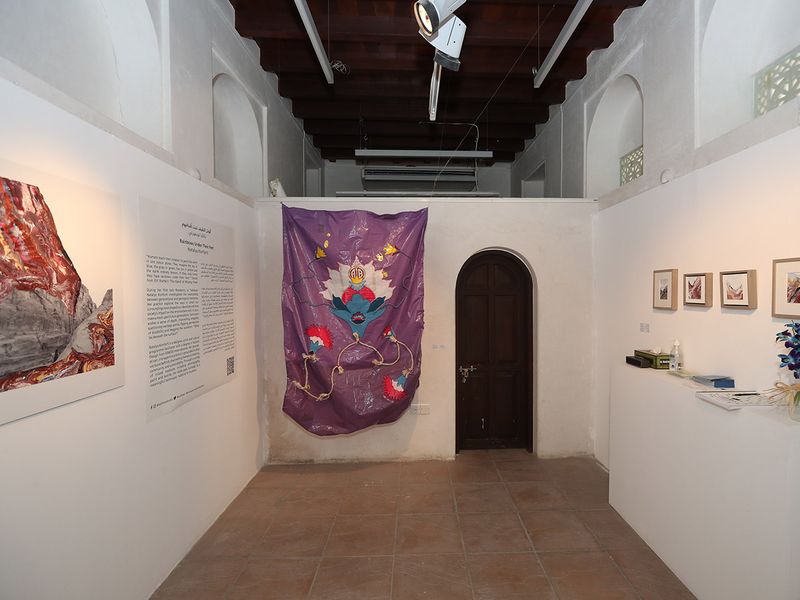
The author’s description of the subterranean, the artist, says mirrored her mixed media artwork. She captured images of geological formations on mountain trails, then painted a rainbow of colours on them, which were printed on paper and on Alucobond boards. A large part of this series was an outcome of Natalya’s hiking trips with her family during the pandemic in the Hajar mountains and in Wadi Rum, Jordan. Walking along these mountains gave her an opportunity to have intimate conversations with friends and family about life challenges.
‘To me mountains embody complex inner worlds, they are beautiful, but formed under tremendous pressure. While we perceive mountains as stable and strong, they are, in fact, the product of tectonic shifts with all their inner workings visible. This depth and contradiction seemed like a perfect metaphor for the inner struggles we all go through, but which are not always visible from the surface,’ she explains.
In her practice, Natalya says, she gravitates towards found and scavenged materials, explaining the creation of the third aspect of her residency - the wasteland quilts. These life-sized plastic quills were created from discarded packaging ropes and other foraged materials, she found awash on beaches and during treks. Taking a cue from archaeologists unearthing objects that document the history of civilization, the artist, went ahead by capturing our modern day plastic legacy - left behind from picnics and camping trips - a testimony of stories and cultures for future generations.
From Beksul, a Korean sugar brand packaging, to local Bayara spices, to shreds of foil birthday balloons and ropes found by Natalya’s mum on the beaches of the French-English Channel – the wasteland quilts are blankets of artefacts, each with a past of its own. ‘I would like people to think about what we leave behind, both in terms of discarded materials on a day-to-day basis as well as the stories, culture and knowledge that we pass on to future generations.’ she says.
Natalya, a French American, who moved to Dubai, five years ago, also holds a degree in fashion design. Her training as a designer, she says, has fostered a sensibility to colour palettes and decorative arts, and an affinity to textile crafts. Her visual practice draws upon the transformational nature of journeys, channelling themes of memory, community and sustainability. One of her more personal and ongoing art projects is Sister Octopi, co-created with her cousin, Justine Formentelli, based in the UK. Through this multi-city collaborative art project, the cousins have tackled their family grief of losing three uncles and two cousins to suicide, depression and bipolar disorder. After exhibiting at DIFC Art Nights 2021 and World Art Fair 2022, Sister Octopi collections are due to make an appearance in London this March.
At the moment, Natalya is basking in the happiness of visitors’ comments she received from her unusual exhibits. ‘The most common reaction I heard was that the combination of medium were unexpected and new. Most of them were intrigued by the textures across all bodies of work and I found it interesting to watch them attempt to work out how the pieces were created. I also noticed that they recognised bits of themselves in certain artworks.’





